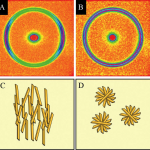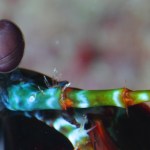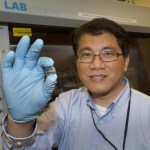NSLS
X-ray diffraction patterns reveal the orientation of fat crystals. The distribution and directionality of these crystal nanostructures (parallel to the shear field in C, randomly arranged in D) affects the flavor and texture of foods.
From butter in croissants to cocoa solids in chocolate, edible fats pack a flavor punch that delights like no other macronutrient we consume. Fats are the most energy dense macronutrients, providing more than twice as many kilocalories per gram as proteins or carbohydrates, which may be the reason we’ve developed a taste for them. Fats are an efficient method…
Mantis shrimp, or stomatopods, are the planet’s most powerful bare-knuckle boxers, armed with dactyl clubs that literally fly faster than a speeding .22 caliber bullet. Each strike boils the surrounding water and creates a tiny cavitation bubble, which then implodes with a sonic pop that can render targets unconscious. Consider that: if the strike itself doesn’t get you, its aftershock will. And that’s just the variety of stomatopod equipped with blunt fists - others launch their lance-like arms to pierce prey.
These little lobster cousins, usually between 4 and 12 inches…
This guest post was written by Mona S. Rowe, science writer for Brookhaven National Laboratory's National Synchrotron Light Source (NSLS) and NSLS-II.
The quest to authenticate an unknown Rembrandt painting, titled "Old Man with a Beard," hit a dramatic high at the National Synchrotron Light Source (NSLS) at Brookhaven National Laboratory. Using an advanced x-ray detector developed at NSLS, scientists found compelling evidence that the famous Dutch master did indeed have his own hand on the painting.
"After doing the experiments at NSLS, I felt that the painting I held in my hands was a…
Jason Graetz, left, and Jiajun Chen at NSLS beamline X14A with their transparent reactor for viewing chemistry in real time.
Here's a recipe for basic chemistry: Mix a bunch of stuff in a reaction vessel and see what happens. Only you don't really see the action taking place -- unless you have some way to visualize the molecular magic.
Researchers at Brookhaven National Laboratory have developed just such a technique: They've fabricated a transparent chemical reactor vessel that allows x-rays to pass through and capture the chemical changes as they take place.
They recently used this…
The following guest post was written by Wei-Qiang Han, a materials scientist working at Brookhaven Lab's Center for Functional Nanomaterials.
Wei-Qiang Han
With gasoline prices still hovering near $4 per gallon, scientists at Brookhaven Lab's Center for Functional Nanomaterials (CFN) are helping to develop electric vehicles capable of driving hundreds of miles on a single charge. A new compound of five tin atoms and one iron atom (FeSn5) created at the CFN is another development along the road to higher capacity lithium-ion batteries for those vehicles of the future.
Compared to other…
Hair breaks. It singes. It falls out. It might not be the strongest feature of living human bodies, but hair is one of the best-preserved tissues of dead ones, providing a record of diet, age, metabolism, and, sometimes, even the cause of death.
Ferdinand II*
With intense beams of x-rays at Brookhaven's National Synchrotron Light Source (NSLS), a team of researchers is using hair samples collected from the decomposed bodies of two 15th century Italian royalty to determine how they really died.
The subjects: Ferdinand II (1467-1496)* and Isabella (1470-1524) of Aragon, a medieval kingdom…
In news that may shake the cranberry juice industry to its core, new atomic-level "snapshots" reveal how bacteria such as E. coli produce and secrete sticky appendages called pili, which help the microbes attach to and infect human bladder cells.
These crystal structures -- produced at the National Synchrotron Light Source (NSLS) at Brookhaven Lab and the European Synchrotron Radiation Facility in Grenoble, France -- unravel a complex choreography of protein-protein interactions that will aid in the design of new antibacterial drugs. Finding ways to interfere with pili formation could help…
A little more than one year ago, on the day of its groundbreaking ceremony, the National Synchrotron Light Source II (NSLS-II) construction site was nothing more than a whole lot of dirt. Today, it's...well, take a look for yourself.
The NSLS-II construction site on the day of the groundbreaking ceremony, June 15, 2009, and...
...exactly one year later
Construction is quickly progressing on the $912 million facility, which will be the world's most brilliant light source. Eh, what's a "light source?" Basically, it's a particle accelerator that, in a controlled manner, sheds light of…






